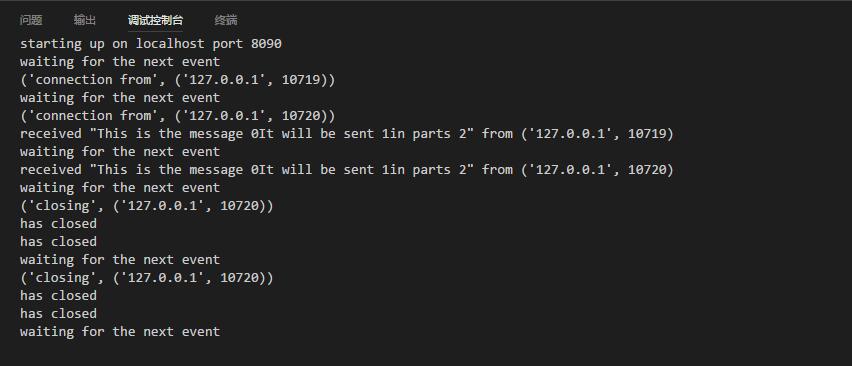基于python select.select模块通信的实例讲解
要理解select.select模块其实主要就是要理解它的参数, 以及其三个返回值。
select()方法接收并监控3个通信列表, 第一个是所有的输入的data,就是指外部发过来的数据,第2个是监控和接收所有要发出去的data(outgoing data),第3个监控错误信息在网上一直在找这个select.select的参数解释, 但实在是没有, 哎...自己硬着头皮分析了一下。
readable, writable, exceptional = select.select(inputs, outputs, inputs)
第一个参数就是服务器端的socket, 第二个是我们在运行过程中存储的客户端的socket, 第三个存储错误信息。
重点是在返回值, 第一个返回的是可读的list, 第二个存储的是可写的list, 第三个存储的是错误信息的list。
这个也不必深究, 看看代码自己分析下就能有大概理解。
网上所有关于select.select的代码都是差不多的, 但是有些不能运行, 或是不全。我自己重新写了一份能运行的程序, 做了很多注释, 好好看看就能搞懂
服务器端:
# coding: utf-8
import select
import socket
import Queue
from time import sleep
# Create a TCP/IP
server = socket.socket(socket.AF_INET, socket.SOCK_STREAM)
server.setblocking(False)
# Bind the socket to the port
server_address = ('localhost', 8090)
print ('starting up on %s port %s' % server_address)
server.bind(server_address)
# Listen for incoming connections
server.listen(5)
# Sockets from which we expect to read
inputs = [server]
# Sockets to which we expect to write
# 处理要发送的消息
outputs = []
# Outgoing message queues (socket: Queue)
message_queues = {}
while inputs:
# Wait for at least one of the sockets to be ready for processing
print ('waiting for the next event')
# 开始select 监听, 对input_list 中的服务器端server 进行监听
# 一旦调用socket的send, recv函数,将会再次调用此模块
readable, writable, exceptional = select.select(inputs, outputs, inputs)
# Handle inputs
# 循环判断是否有客户端连接进来, 当有客户端连接进来时select 将触发
for s in readable:
# 判断当前触发的是不是服务端对象, 当触发的对象是服务端对象时,说明有新客户端连接进来了
# 表示有新用户来连接
if s is server:
# A "readable" socket is ready to accept a connection
connection, client_address = s.accept()
print ('connection from', client_address)
# this is connection not server
connection.setblocking(0)
# 将客户端对象也加入到监听的列表中, 当客户端发送消息时 select 将触发
inputs.append(connection)
# Give the connection a queue for data we want to send
# 为连接的客户端单独创建一个消息队列,用来保存客户端发送的消息
message_queues[connection] = Queue.Queue()
else:
# 有老用户发消息, 处理接受
# 由于客户端连接进来时服务端接收客户端连接请求,将客户端加入到了监听列表中(input_list), 客户端发送消息将触发
# 所以判断是否是客户端对象触发
data = s.recv(1024)
# 客户端未断开
if data != '':
# A readable client socket has data
print ('received "%s" from %s' % (data, s.getpeername()))
# 将收到的消息放入到相对应的socket客户端的消息队列中
message_queues[s].put(data)
# Add output channel for response
# 将需要进行回复操作socket放到output 列表中, 让select监听
if s not in outputs:
outputs.append(s)
else:
# 客户端断开了连接, 将客户端的监听从input列表中移除
# Interpret empty result as closed connection
print ('closing', client_address)
# Stop listening for input on the connection
if s in outputs:
outputs.remove(s)
inputs.remove(s)
s.close()
# Remove message queue
# 移除对应socket客户端对象的消息队列
del message_queues[s]
# Handle outputs
# 如果现在没有客户端请求, 也没有客户端发送消息时, 开始对发送消息列表进行处理, 是否需要发送消息
# 存储哪个客户端发送过消息
for s in writable:
try:
# 如果消息队列中有消息,从消息队列中获取要发送的消息
message_queue = message_queues.get(s)
send_data = ''
if message_queue is not None:
send_data = message_queue.get_nowait()
else:
# 客户端连接断开了
print "has closed "
except Queue.Empty:
# 客户端连接断开了
print "%s" % (s.getpeername())
outputs.remove(s)
else:
# print "sending %s to %s " % (send_data, s.getpeername)
# print "send something"
if message_queue is not None:
s.send(send_data)
else:
print "has closed "
# del message_queues[s]
# writable.remove(s)
# print "Client %s disconnected" % (client_address)
# # Handle "exceptional conditions"
# 处理异常的情况
for s in exceptional:
print ('exception condition on', s.getpeername())
# Stop listening for input on the connection
inputs.remove(s)
if s in outputs:
outputs.remove(s)
s.close()
# Remove message queue
del message_queues[s]
sleep(1)
客户端:
# coding: utf-8
import socket
messages = ['This is the message ', 'It will be sent ', 'in parts ', ]
server_address = ('localhost', 8090)
# Create aTCP/IP socket
socks = [socket.socket(socket.AF_INET, socket.SOCK_STREAM), socket.socket(socket.AF_INET, socket.SOCK_STREAM), ]
# Connect thesocket to the port where the server is listening
print ('connecting to %s port %s' % server_address)
# 连接到服务器
for s in socks:
s.connect(server_address)
for index, message in enumerate(messages):
# Send messages on both sockets
for s in socks:
print ('%s: sending "%s"' % (s.getsockname(), message + str(index)))
s.send(bytes(message + str(index)).decode('utf-8'))
# Read responses on both sockets
for s in socks:
data = s.recv(1024)
print ('%s: received "%s"' % (s.getsockname(), data))
if data != "":
print ('closingsocket', s.getsockname())
s.close()
写代码过程中遇到了两个问题, 一是如何判断客户端已经关闭了socket连接, 后来自己分析了下, 如果关闭了客户端socket, 那么此时服务器端接收到的data就是'', 加个这个判断。二是如果服务器端关闭了socket, 一旦在调用socket的相关方法都会报错, 不管socket是不是用不同的容器存储的(意思是说list_1存储了socket1, list_2存储了socket1, 我关闭了socket1, 两者都不能在调用这个socket了)
服务器端:

客户端:

以上这篇基于python select.select模块通信的实例讲解就是小编分享给大家的全部内容了,希望能给大家一个参考,也希望大家多多支持【听图阁-专注于Python设计】。
